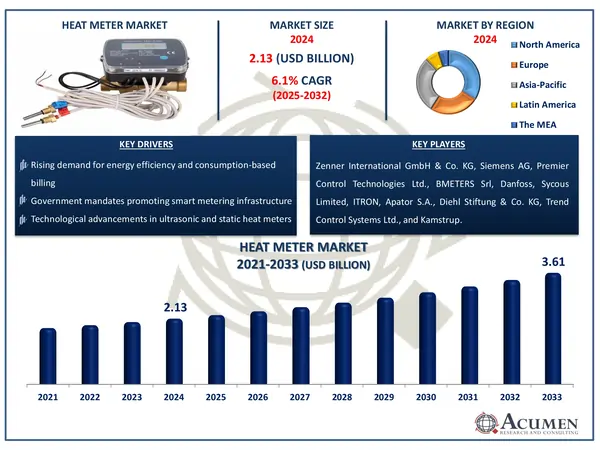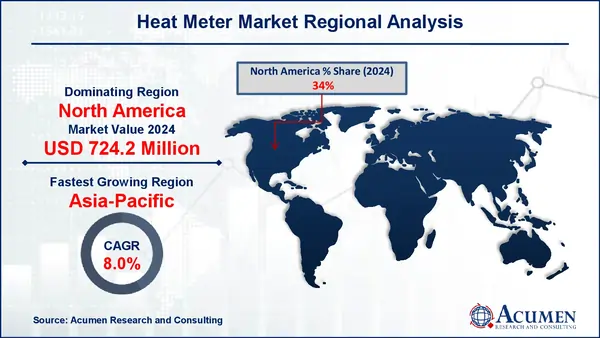December 2024
The Global Heat Meter Market Size accounted for USD 2.13 Billion in 2024 and is estimated to achieve a market size of USD 3.61 Billion by 2033 growing at a CAGR of 6.1% from 2025 to 2033.
The Global Heat Meter Market Size accounted for USD 2.13 Billion in 2024 and is estimated to achieve a market size of USD 3.61 Billion by 2033 growing at a CAGR of 6.1% from 2025 to 2033.

A heat meter is a device that measures the amount of thermal energy used by a heating or cooling system. It calculates energy consumption by monitoring the flow rate of a heat transfer fluid (often water) and the temperature differential between the fluid's entry and exit points from the system. Heat meters are commonly used in residential, commercial, and industrial facilities to monitor energy usage for heating and cooling, particularly in district heating networks. These meters aid in precise billing, energy conservation, and system efficiency measurement. They can be mechanical, ultrasonic, or electromagnetic, depending on their design. Heat meters provide clients and utility providers with real-time data, allowing them to optimize energy use and minimize operational costs in heating and cooling systems.
|
Market |
Heat Meter Market |
|
Heat Meter Market Size 2024 |
USD 2.13 Billion |
|
Heat Meter Market Forecast 2033 |
USD 3.61 Billion |
|
Heat Meter Market CAGR During 2025 - 2033 |
6.1% |
|
Heat Meter Market Analysis Period |
2021 - 2033 |
|
Heat Meter Market Base Year |
2024 |
|
Heat Meter Market Forecast Data |
2025 - 2033 |
|
Segments Covered |
By Type, By Connectivity, By End-Use, and By Geography |
|
Regional Scope |
North America, Europe, Asia Pacific, Latin America, and Middle East & Africa |
|
Key Companies Profiled |
Zenner International GmbH & Co. KG, Siemens AG, Premier Control Technologies Ltd., BMETERS Srl, Danfoss, Sycous Limited, ITRON, Apator S.A., Diehl Stiftung & Co. KG, Trend Control Systems Ltd., and Kamstrup. |
|
Report Coverage |
Market Trends, Drivers, Restraints, Competitive Analysis, Player Profiling, Covid-19 Analysis, Regulation Analysis |
The heat meter market is rapidly expanding, thanks to a mix of macroeconomic trends and legislative measures. The growing use of district heating systems, particularly in urban areas across Europe, is a significant contributor to this increase. The European Union's Energy Efficiency Directive requires heat meters to be installed in all district heating and cooling systems in order to allow for consumption-based billing. This regulatory drive has resulted in the widespread adoption of heat metering devices in countries such as Germany, Denmark, and Sweden. Similarly, rising urbanization in Asia-Pacific countries such as China and India is increasing demand for efficient energy distribution systems, encouraging the use of heat meters in newly built residential and commercial buildings.
Governments throughout the world are also focusing more on energy efficiency as part of their climate change policy, which promotes the usage of heat metering systems. For example, India's Central Electricity Authority actively promotes the use of smart metering and energy-saving technologies in commercial infrastructure. Real-time monitoring and remote data collection are now possible due to technology advancements in the field, particularly with ultrasonic and IoT-enabled heat meters. These enhancements increase billing accuracy and allow electricity providers and customers greater operational control.
The market faces several challenges. The high upfront cost of installing smart and modular heat meters is typically a disincentive, especially in price-sensitive areas. Furthermore, in many underdeveloped nations, there is a lack of information about the long-term benefits of heat metering, which prevents widespread implementation. Retrofitting existing infrastructure with modern heat meters also presents technical and logistical difficulties, which can make integration unfeasible in certain scenarios.
Nonetheless, the market holds considerable opportunities. The global movement towards smart city development is generating strong demand for interconnected and energy-efficient technologies, with smart heat meters playing a central role. There is also an increasing interest in retrofitting older buildings with modern heat metering systems, particularly in Europe and North America. Furthermore, the increasing transition to IoT and wireless communication technologies has prepared the path for the creation of next-generation heat meters that can do remote diagnostics and performance analytics. Emerging regions in Asia and Latin America are likely to play a big role in the market's future growth as urban infrastructure evolves and regulatory frameworks strengthen.
The worldwide market for heat meter is split based on type, connectivity, end-use, and geography.
According to heat meter industry analysis, the static segment dominates the market due to its superior accuracy, low maintenance requirements, and long service life. Unlike mechanical meters, static heat meters use ultrasonic or electromagnetic principles to eliminate moving parts and save wear and tear. This improves durability and ensures that performance remains consistent with time. Furthermore, static meters offer extra features such as remote reading, data logging, and integration with smart energy management systems, making them ideal for modern infrastructure and district heating. Their ability to work efficiently under a variety of flow conditions and low-pressure drops makes them attractive among utilities and customers, leading to their global market dominance.
The wired segment of the heat meter market is the largest and is predicted to grow significantly between 2025 and 2033 because to its dependability, cost-effectiveness, and compatibility with current infrastructure. Wired heat meters allow dependable data transfer with minimal signal interference, making them ideal for large residential complexes and industrial operations. Their dependable performance in places where wireless signals may be degraded is an important factor driving demand. Furthermore, many utility companies prefer wired solutions because they are easier to integrate into centralized energy management systems and pose less cybersecurity risks than wireless alternatives. As district heating networks spread throughout Europe and Asia, the demand for long-lasting and precise wired solutions grows, reinforcing their expanding position in the worldwide heat meter market.
In terms of heat meter market forecast, the residential segment now leads the industry and is predicted to develop further, owing to rising urbanization, increased building of multi-family housing units, and growing awareness about energy conservation. Heat meters in residential settings provide for accurate, consumption-based pricing, encouraging customers to control their heating usage effectively. Individual metering in apartment complexes is required by European regulations under the Energy Efficiency Directive, which boosts uptake even further. Furthermore, government measures supporting smart home technology and energy-efficient infrastructure are hastening the adoption of heat meters in residential structures. With expanding district heating networks and a global push toward carbon-neutral housing, demand for residential heat meters is likely to continuously increase, maintaining this segment's market leadership.
North America
Europe
Asia-Pacific
Latin America
The Middle East & Africa

The heat meter market has distinct geographic characteristics, with North America dominating market share and Asia-Pacific emerging as the fastest-growing region. North America is predicted to account for a large portion of the global heat meter market. This dominance is due to stringent energy efficiency standards, widespread usage of district heating systems, and the incorporation of renewable energy sources. The United States, in particular, is expected to reach its peak market valuation by 2033, growing at the fastest CAGR between 2025 and 2033. The region's emphasis on environmental sustainability, combined with the need for exact energy monitoring, has created a need for advanced heat metering systems.
In contrast, the Asia-Pacific region is anticipated to experience the fastest growth in the industry, with a CAGR exceeding 8% during the heat meter market forecast period. Rapid industrialization, urbanization, and the development of smart cities in countries like China and India are key drivers of this growth. China's market is predicted to grow significantly by 2033, with a strong CAGR. Government initiatives aimed at improving energy efficiency and incorporating renewable energy sources have increased demand for heat meters in the region. These regional trends show the global push for energy efficiency and the importance of heat meters in achieving sustainable energy management.
Some of the top heat meter companies offered in our report include Zenner International GmbH & Co. KG, Siemens AG, Premier Control Technologies Ltd., BMETERS Srl, Danfoss, Sycous Limited, ITRON, Apator S.A., Diehl Stiftung & Co. KG, Trend Control Systems Ltd., and Kamstrup.
Looking for discounts, bulk pricing, or custom solutions? Contact us today at sales@acumenresearchandconsulting.com
December 2024
September 2022
October 2023
March 2023